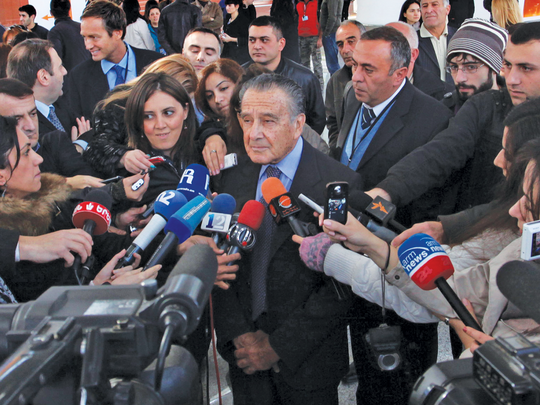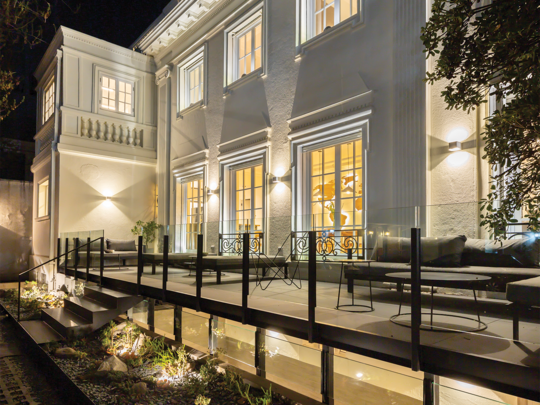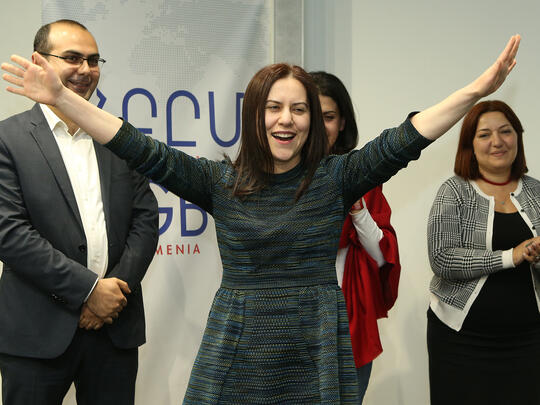The distant shores of South America that beat some 14,000 kilometers from the high mountains of Armenia first inspire little hope of an Armenian presence on the continent. But leave it to the thousands upon thousands fleeing a genocidal Ottoman Empire to sail into the New World and flourish and thrive against all odds.
For the Armenian Republic, Latin America remains a fairly new destination. While its newfound independence from the splintered Soviet realm gave Armenia leave to initiate diplomatic relations with the countries of the south, the follow up has yet to live up to potential.
Outside a handful of interspersed state visits and the irregular establishment of permanent missions, Armenia’s rapprochement with Latin America has been possible largely thanks to the efforts of influential Armenian communities centered in Argentina, Brazil and Uruguay.
The last Armenian head of state to visit South America was former president Serzh Sargsyan, who traveled to Brazil in 2016 to show his support to the Armenian athletes competing in the Rio Olympics and attend the laying of the foundation stone of Armenia’s first embassy in its capital, Brasília. Brief talks with his Brazilian counterpart Michel Temer and other high-ranking officials, and a reception in his honor organized by the Armenian community of São Paulo, were also on the president’s agenda.
The visit to Brazil followed a prior week-long tour of Argentina, Uruguay and Chile in July 2014 that sought to strengthen bilateral ties between Armenia and the South American states through political, economic and cultural cooperation. While President Sargsyan did secure a series of agreements with his hosts, the follow-up to these has failed to produce tangible results and Armenia’s new leadership has yet to deliver on past promises. Now in its second year, the government of Nikol Pashinyan is attempting to refresh its Latin foreign relations strategy, while stepping up efforts to re-engage with the communities of its third largest diaspora.
Taking Stock of Trade
Meanwhile, trade between Armenia and Iberian America is lopsided, dominated by imports to Armenia with little to show in the way of exports despite their great potential, according to Hovsep Seferian, former vice consul, press and trade attaché of the Brazilian embassy in Armenia.
In 2019 alone, trade turnover between Armenia and Central and South America stood at a staggering 99.5% in favor of Latin imports, with Brazilian raw tobacco, sugar, poultry meat, car parts and other products taking the lion’s share of the $105 million USD in goods imported by Armenia—the norm in the past five years, according to the country’s Ministry of Economy. Its next major Latin American importers are Mexico and Argentina, with Uruguay trailing far behind.
Seferian explains this by the lack of recognition of Armenian products in Latin markets because of their inadequate promotion by Armenia. “Every time I see dry apricots made in Turkey in a Brazilian grocery, I’m disappointed by the missed opportunity,” he says.
Seferian cites the drawn-out geography, language barrier and poor knowledge of local import/export regulations, as well as expensive customs duties as just some of the reasons why hardly any Armenian producer is willing to take the risk of exporting to South America. “This is why it is so important that the Armenian government offer its support in developing beneficial trade opportunities for local producers,” he adds.
The new outlook brought about by the Velvet Revolution of 2018, coupled with the recurring threat of Turkish and Azerbaijani anti-Armenian lobbying in the region, are pushing Armenia to adopt a more proactive foreign policy in Latin America—one that does not rest so heavily on the shoulders of the local Armenian diaspora.
As a general rule, good economic relations foster development in other fields of interest ranging from politics to international relations and culture.
Warm Up Exercises
Karen Martirosyan, head of the Central and South America division of the Armenian Ministry of Foreign Affairs, spells out the ministry’s strategy for breaking through to the southern continent’s typically self-interested state craft, emphasizing the potential of parliamentary diplomacy to “break the ice” and build stronger relations with its Latin partners.
He cites the welcoming of three new consular offices in Yerevan in 2019, including the honorary consulate of the United Mexican States, the Eastern Republic of Uruguay, and more recently the Republic of Chile, as testament to South America’s growing interest in Armenia. The opening of the Uruguayan consulate, negotiated in 2018 between the then newly-appointed Foreign Minister of Armenia Zohrab Mnatsakanyan and his Uruguayan counterpart Rodolfo Nin Novoa, is also described by Martirosyan as a “potent symbol of our positive interactions with our Latin American partners on the floor of international organizations.”
Consecutive visits to Armenia and Artsakh by the Mexico-Armenia Friendship Group in 2017 and again in early 2020, while cause for Azerbaijani dismay in the case of the latter, are bringing national talking points to the forefront of Armenia’s political agenda with the Central American federation. On their latest trip to Armenia on January 20, Chairman Adolfo Torres Ramírez briefed colleagues in the Armenian legislature on their efforts to officially recognize the Armenian Genocide and promised to continue to raise awareness about the status of the conflict in Artsakh. A formal invitation to Mexico was also extended to the president of Armenia’s National Assembly Ararat Mirzoyan in a bid to usher in a new era of Armenian-Mexican relations.
Coming in strong is also First Lady Anna Hakobyan who travelled to Brazil and Argentina in the lead up to International Women’s Day earlier this March to emphasize, together with her Latin counterparts, the role of first ladies in furthering state relations and implementing joint projects of global consequence. “The status of the first lady should serve the good of her people and the world at large,” Mrs. Hakobyan told Argentina’s First Lady Fabiola Yáñez before talking about the two charitable foundations she manages and her Women for Peace campaign that wants to involve Armenian and Azerbaijani women in the peaceful resolution of the Artsakh conflict. Mrs. Yáñez, and First Lady Michelle de Paula Firmo Reinaldo Bolsonaro of Brazil a day before her, reciprocated with their own social projects in their respective countries. Both are scheduled to visit Armenia later this autumn for further talks.
Politics is Economics
All things considered, the crux of Armenia’s bid for stronger political ties to the wider continent remains the still largely untapped trade potential between the two regions. Mirroring the view of former vice consul Seferian that “politics are a consequence of economics,” Martirosyan agrees that “as a general rule, good economic relations foster development in other fields of interest ranging from politics to international relations and culture.”

A key element in Armenia’s efforts to promote greater economic understanding with Latin America is its potential as a commercial gateway to the 170 million-strong common market of the Eurasian Economic Union (EAEU), explains Martirosyan. Lucrative markets in Iran and the wider Middle East are also garnering Latin America’s attention.
Meanwhile, making progress on the ground are presidential couple Armen and Nune Sarkissian, who last June hosted the enterprising women of the Argentine Pollera Pantalón initiative to showcase Armenia and its investment potential. An impulse of the prominent Eurnekian family, its representative Juliana del Aguila credited her family’s Armenian origins, and close relationship to the country and the Sarkissians, as catalyzers of the visit. “But rather than a simple gathering of friends, our objective was to identify opportunities for cooperation that will transform into real projects moving forward,” explains del Aguila, who is also a member of the Pollera group.

In addition, talks of a TUMO franchise in Argentina and joint projects between Armenian and Argentine rural women are currently underway in the framework of a developing cooperation agenda, according to del Aguila.
Banking on Change
Maintaining that outward gaze, Seferian is calling on the government to make use of existing assets to lure Brazilian and other South American businesses to Armenia. “Two of São Paulo’s prominent private banks—Banco Induscred S.A. and Banco Sofisa S.A.—are managed by Armenian families. Now imagine if Armenia’s ambassador to Brazil, or better yet, a designated trade attaché stationed in São Paulo, were to approach these banking families with an offer to induce their Brazilian clients to invest in Armenia. The economic impact would be huge,” says Seferian.
Stronger economic and political relations with Latin America also hold the promise of a closer rapport with the “treasure” that are its local Armenian communities. While highly appreciative of the philanthropic aid shown to Armenia over its 30 years of independence, Martirosyan is calling on fellow compatriots to initiate a more diversified agenda of economic engagement, namely in the form of investments. “I think it’s a more sustainable model of interaction and cooperation—one that has the power to counter the inevitable loss of Armenian identity resulting from increased assimilation with the local population,” he says.


Unofficial Statesmanship
And where the state has lagged behind, the baton of progress has been picked up by local NGOs and business initiatives intent on exploiting the full potential of enhanced economic and socio-cultural relations between Armenia and its Latin American partners.
From the Fighting Infectious Diseases in Emerging Countries (FIDEC) Armenia Foundation, established by Argentine-Armenian M.D. Daniel Stamboulian, that brings some of Argentina’s top pediatricians to hospitals in Yerevan and Gyumri for specialized consultations; to the first-ever Armenia-Brazil Business Forum organized in 2018 under the auspices of Business Armenia Foundation, the field is buzzing with opportunity and some are taking advantage.
As one of the leading global nonprofits involved in nation-building, the Armenian General Benevolent Union (AGBU) has also been making strides. Late last year, AGBU Armenia’s leadership oversaw the signing of a joint initiative agreement between the Argentine Fund for South-South and Triangular Cooperation (FOAR) and AGBU South America that will bring agro-experts from the Argentine Instituto Nacional de Tecnología Agropecuaria (INTA) to Armenia later this year to help establish a five-hectare experimental plot in the region of Armavir.
“The aim of this AGBU-powered project, which is implemented by the Armenian National Agrarian University, is to introduce local farmers to state-of-the-art farming techniques that will help them increase their yields,” explains Vasken Yacoubian, AGBU Armenia president, who was present at the signing ceremony. He added that the project is “a beautiful example of AGBU chapters in Argentina, Brazil and Uruguay joining forces to bring positive change to Armenia.”
Earlier this February, AGBU Armenia also hosted the first consul general of Uruguay in Armenia to introduce on-going projects in Armenia and Artsakh, including those of AGBU in South America, and share ideas for future partnerships.

Betting on Youth
Despite everyone’s best efforts and more than a century after the first wave of Armenian immigrants poured in South America seeking refuge from certain annihilation, the continent remains off the beaten path of Armenia. The passing of time and powers of assimilation that be are only expanding the generational gap within local communities and with the homeland. Defining a role for Latin America’s Armenian youth in the larger scheme of Armenia’s nation-building efforts, despite the language barriers facing third and fourth generation diasporans, is also worth pursuing.
Government officials and business representatives agree that the antidote to these ills rests in the hands of a dedicated diasporan youth exemplified by people like Maria Rosa Anazonian, a Buenos Aires-born Armenian entrepreneur who made Armenia her home after a six-month volunteering stint with Birthright Armenia. Making use of her Armenian connections from Argentina to Mexico, Anazonian is bridging the continental divide by enticing young diasporans to travel and even take up residence in Armenia. “I want their trip to be the beginning of a connection to Armenia,” she says.
Her numbers speak for themselves. Since founding Mari Anazonian Travel and Financial Planning in 2018, some 100 enthusiasts from Latin America have made their way to Armenia on travel and volunteering expeditions, 70 of them in 2019 alone—a 130% increase from the previous year. But Anazonian believes there is “plenty more room for improvement,” while admitting that moving to Armenia is not without its challenges.
A menu of counter-incentives ranging from costly, multi-city flights to linguistic acclimatization and a general unawareness of the realities of a life in Armenia have stymied repatriation. Anazonian is betting on the country’s improving socioeconomic landscape and a sense of patriotism still present in the Latin-Armenian youth “to transform the fantasy of repatriation into reality.”
The less saturated markets of Armenia and relative stability of the dollar as compared to Argentina, for example, also make it easier to start a successful business in Armenia, making it that much more attractive for Latin Armenians looking to make it.
Meanwhile, a reinvigorated Armenian government is buying in on the power of modern technology and the recent influx of low-cost airlines to bridge the geographical divide with South America and implicate the young and vibrant of the local diasporas in the developmental hype sweeping the country.
“I think it would be very interesting for the Armenian youth of Latin America to travel to post-revolutionary Armenia and interact with their local peers, because they have so much more to share than they know and the exchange of opinions between them could even foster common solutions to both national and global problems,” says Martirosyan.
The success of this new approach remains to be seen, but with so much potential to spare, odds favor a productive and fruitful relationship.
Banner photos by Thomas Dekiere/Shutterstock and by iStock /Marchello74.




















